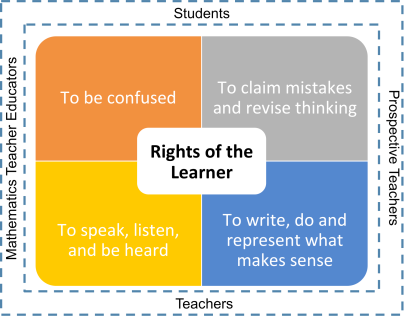It was in my process of learning to teach elementary math methods that I also learned about the Rights of the Learner. Olga Torres, a well-known and respected bilingual elementary teacher and teacher educator in Arizona, wanted to create a space for her third grade students to feel safe when learning math, but she needed a reminder for them each time they stepped into the risky space of knowing that you don’t yet know everything. So Torres came up with the Rights of the Learner. Initially, I learned the rights were: 1. to be confused, 2. to make mistakes, 3. to say what makes sense to you, and 4. to write what makes sense to you.
But over time, those rights have evolved, both for her and for me. Now we agree that our RotL 2.0 could be: 1. to be confused, 2. to claim you’ve made a mistake and to revise your thinking, 3. to speak, listen, and be heard, and 4., to write, do and represent what makes sense to you. What I love about these new rights is that they are more inclusive and expansive. These rights start with the premise that ALL kids come with knowledge and teachers must first begin with that assumption. The RotL argue that what kids and teachers say about a math problem might not be the same, but that shouldn’t discount what kids say just because it isn’t what we as teachers expected them to say or it isn’t what is written in the solution guide in the back of the book. The RotL fundamentally shifts the power from teacher to student. It claims that in this classroom, there is an agreed upon set of principles that we will honor and follow. Principles that should be granted to EVERYONE. EVERY TIME. EVERYWHERE.

Many who are reading this might say “but what do these rights have to do with math? with assessing children’s thinking about math as they are learning?” Great point. Glad you asked, hypothetical person somewhere in the world. Teachers learn about what their kids know and have left to learn through the practice of assessment. They can assess children’s thinking after the conclusion of a long unit/theme/large grouping of standards/year (summative assessment) or they can assess children’s thinking in the moment with a much shorter time frame (formative assessment) (Black and Wiliam, 1998). But there are two other types of assessment: convergent and divergent (Pryor and Croussard, 2008). Convergent Formative Assessments ask “IF the learner knows, understands or can do a predetermined thing” whereas DIVERGENT formative assessments ask “WHAT the learner knows, understands or can do” (Pryor & Crossouard, 2008, p.5). Another way to think of this difference is to ask yourself these questions:
- Can my students give me an answer to a task that I haven’t already predetermined PRIOR to the task?
- Can my students give multiple solutions or methods of communicating their thinking?
- Can I ask supporting, clarifying, or extending questions (Jacobs & Ambrose, 2008) that help me to learn more about my students’ thinking rather than just getting them to say the correct answer?
- Can my students and I co-create experiences or activities that assess THEIR OWN thinking?
- Do I see myself as a facilitator of my students’ learning and not just a sign post to direct them to the “correct path” as outlined in my lesson plan?
- Can my students utilize the notion of Rough Draft Talk (Jansen, Cooper, Vascellaro, & Wandless, 2017) to revise their thinking as they learn more about the topic?
If you answered YAAAAASSSS to these, you’re probably using DIVERGENT formative assessments. And now you’re ready to think more about the Rights of the Learner.
Welcome to the Rights of the Learner Swim Team. The water is just fine. Come on in and wade in the pool for a bit. You don’t need to be an elite swimmer to learn a few swim strokes. Eventually you’ll be diving off the high board soon. Bring your floaties and don’t forget to put on sunscreen. The Texas sun can be brutal.

References
Black, P., & Wiliam, D. (2010). Inside the black box: Raising standards through classroom assessment. Phi Delta Kappan, 92(1), 81-90.
Jacobs, V. R., & Ambrose, R. C. (2008). Making the most of story problems. Teaching Children Mathematics, 15(5), 260-266.
Jansen, A., Cooper, B., Vascellaro, S., & Wandless, P. (2016). Rough-Draft Talk in Mathematics Classrooms. Mathematics Teaching in the Middle School, 22(5), 304-307. doi:10.5951/mathteacmiddscho.22.5.0304
Pryor, J., & Crossouard, B. (2008). A socio‐cultural theorisation of formative assessment. Oxford Review of Education, 34(1), 1-20.

One Reply to “”
Comments are closed.